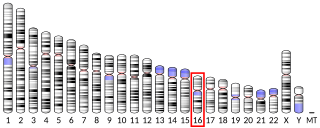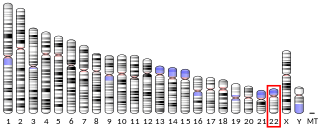
FAS-associated death domain protein, also called MORT1, is encoded by the FADD gene on the 11q13.3 region of chromosome 11 in humans.

Adapter molecule crk also known as proto-oncogene c-Crk is a protein that in humans is encoded by the CRK gene.

Caspase-8 is a caspase protein, encoded by the CASP8 gene. It most likely acts upon caspase-3. CASP8 orthologs have been identified in numerous mammals for which complete genome data are available. These unique orthologs are also present in birds.

Mitogen-activated protein kinase 1, also known as ERK2, is an enzyme that in humans is encoded by the MAPK1 gene.

Mitogen-activated protein kinase 3, also known as p44MAPK and ERK1, is an enzyme that in humans is encoded by the MAPK3 gene.

Mitogen-activated protein kinase 8 is a ubiquitous enzyme that in humans is encoded by the MAPK8 gene.

Protein tyrosine kinase 2 beta is an enzyme that in humans is encoded by the PTK2B gene.

Cyclic AMP-dependent transcription factor ATF-1 is a protein that in humans is encoded by the ATF1 gene.

Calcium/calmodulin-dependent protein kinase type IV is an enzyme that in humans is encoded by the CAMK4 gene.

Serine/threonine-protein kinase 4 is an enzyme that in humans is encoded by the STK4 gene.

The alpha-1B adrenergic receptor (α1B-adrenoreceptor), also known as ADRA1B, is an alpha-1 adrenergic receptor, and also denotes the human gene encoding it. The crystal structure of the α1B-adrenergic receptor has been determined in complex with the inverse agonist (+)-cyclazosin.

Serine/threonine-protein kinase D1 is an enzyme that in humans is encoded by the PRKD1 gene.

Protein kinase C eta type is an enzyme that in humans is encoded by the PRKCH gene.

Ribosomal protein S6 kinase alpha-2 is an enzyme that in humans is encoded by the RPS6KA2 gene.

Cytoplasmic tyrosine-protein kinase BMX is an enzyme that in humans is encoded by the BMX gene.

Serine/threonine-protein kinase N2 is an enzyme that in humans and Strongylocentrotus purpuratus is encoded by the PKN2 gene.

Mitogen-activated protein kinase 12 is an enzyme that in humans is encoded by the MAP3K12 gene.

Dual specificity tyrosine-phosphorylation-regulated kinase 1B is an enzyme that in humans is encoded by the DYRK1B gene.

Caspase recruitment domain-containing protein 10 is a protein in the CARD-CC protein family that in humans is encoded by the CARD10 gene.

Mitogen-activated protein kinase 11 is an enzyme that in humans is encoded by the MAPK11 gene.


























